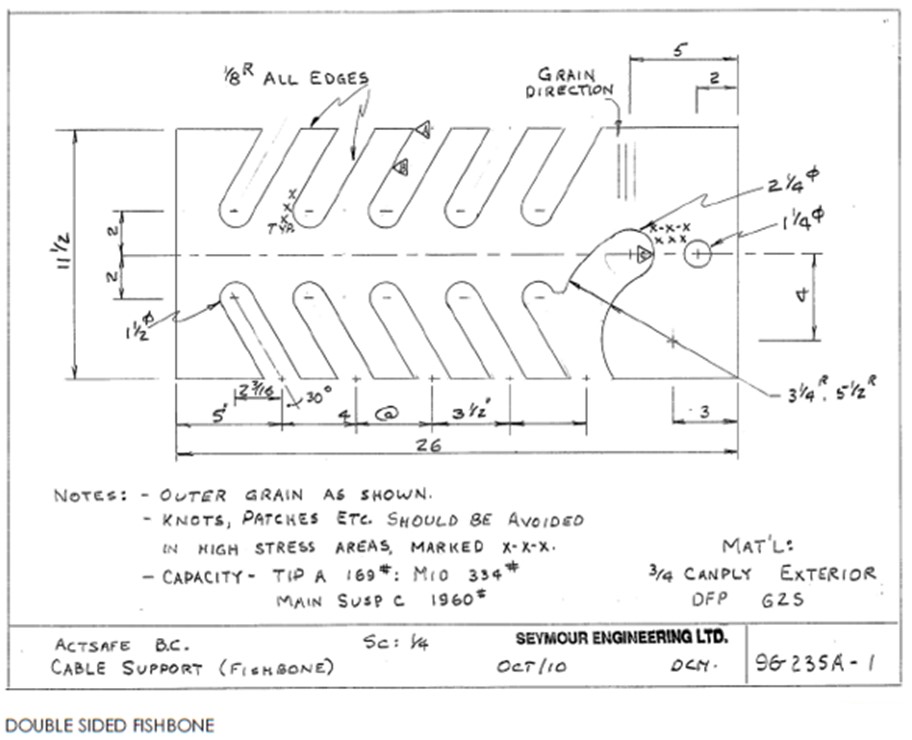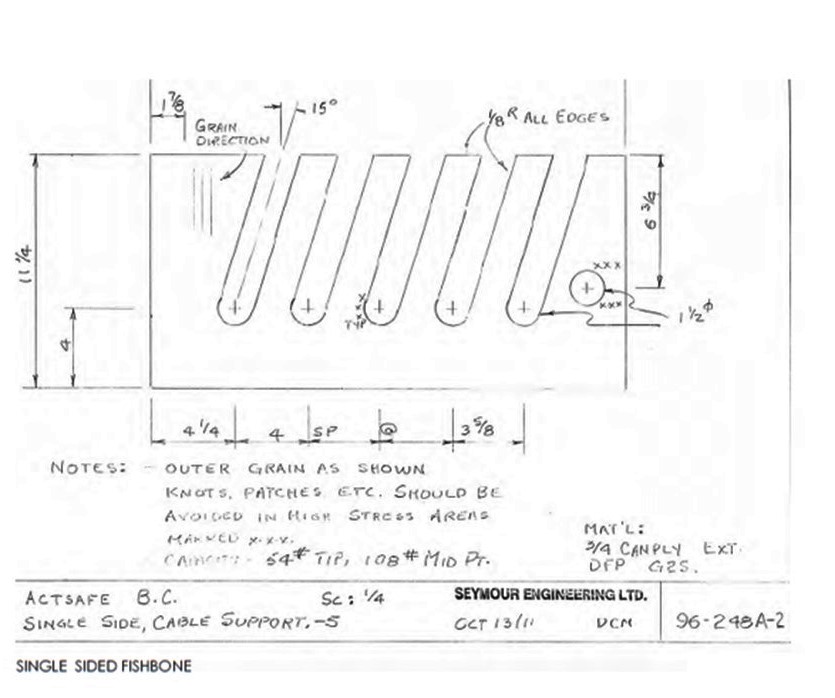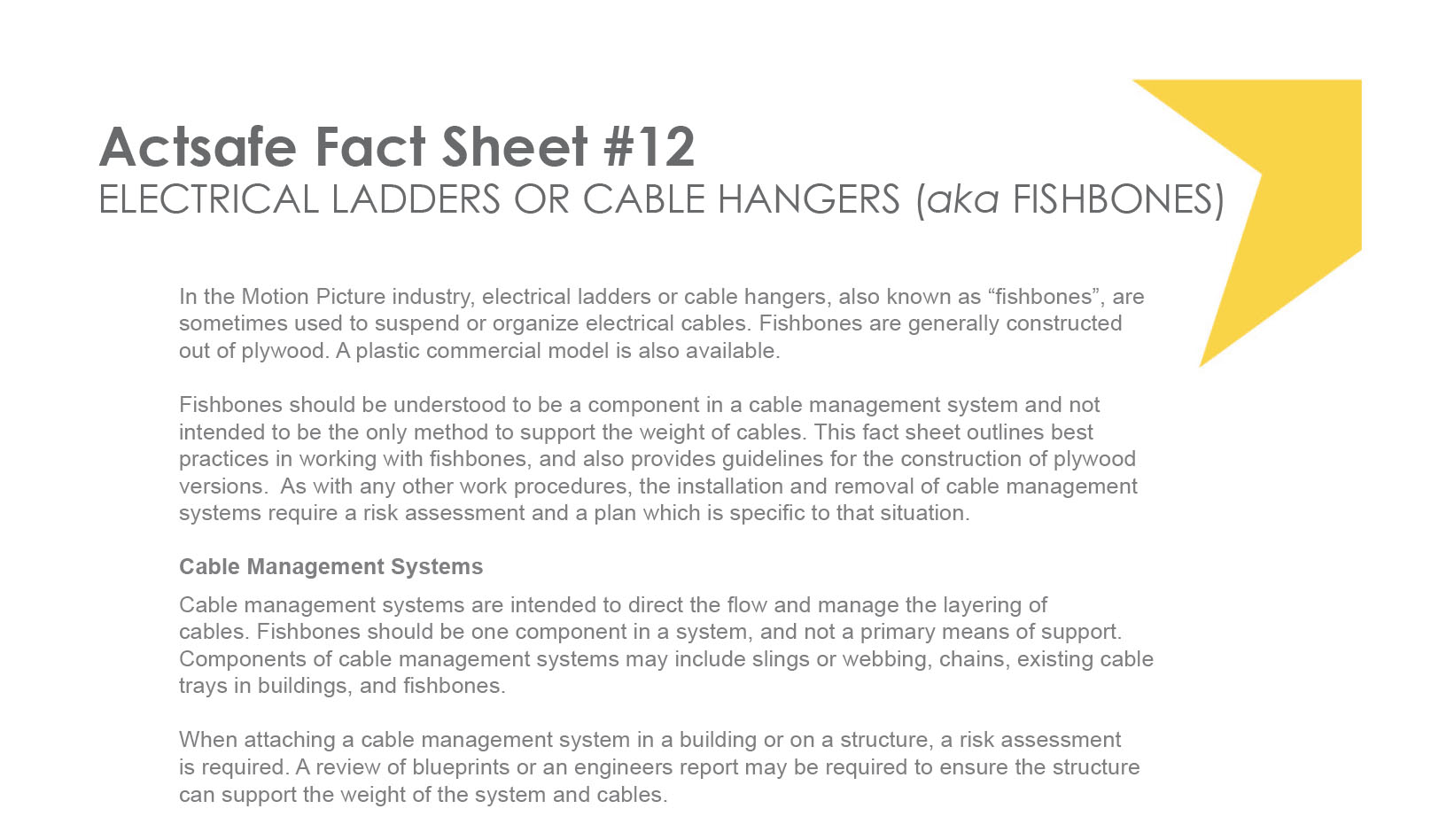In the Motion Picture industry, electrical ladders or cable hangers, also known as “fishbones”, are sometimes used to suspend or organize electrical cables. Fishbones are generally constructed out of plywood. A plastic commercial model is also available.
Fishbones should be understood to be a component in a cable management system and not intended to be the only method to support the weight of cables. This fact sheet outlines best practices in working with fishbones, and also provides guidelines for the construction of plywood versions. As with any other work procedures, the installation and removal of cable management systems require a risk assessment and a plan which is specific to that situation.
Cable Management Systems
Cable management systems are intended to direct the flow and manage the layering of cables. Fishbones should be one component in a system, and not a primary means of support. Components of cable management systems may include slings or webbing, chains, existing cable trays in buildings, and fishbones.
When attaching a cable management system in a building or on a structure, a risk assessment is required. A review of blueprints or an engineers report may be required to ensure the structure can support the weight of the system and cables.
The load carrying ability of plywood fishbones are affected by several variables. As an indication: On a standard design fishbone, if the orientation of the grain is correct and it is built according to the recommendations in this fact sheet, each 4” arm should support 169 pounds at the tip or 334 pounds at midpoint. However, the primary limitation is the main suspension point, which should support a total of 1960 pounds of distributed load (i.e. through a belt type sling).
When planning or installing a cable suspension system, spacing of cable supports should be at 8’ to 10’ intervals. Optimum placement would be alternating chains or slings with fishbones. It is recommended that fishbones be suspended from a rated belt or sling, to avoid wear and resulting weakness on a cable or chain.
If choosing to use chains instead of a rated belt or sling, a risk assessment must be conducted, giving consideration to the potential for wear and the additional weight on the system, which will be different for each installation.
When installing and removing a cable management system, be aware of weight loads and the potential for the transfer of loads from one component in the system to another. Be cautious when installing or removing system components and ensure a secondary weight support. Never let cables suddenly swing free, resulting in a rapid addition of weight on one system component.
When working outdoors near salt water, be aware of potential conductivity issues and avoid the use of chain.
Inspection
Cable management systems should be inspected on a regular basis, with annual inspection being a recommended minimum. Pre and post production inspections are recommended. All system components should be inspected before being installed. Systems should be dated at the time of installation, with dates of inspection noted on the system. Inspections should include a visual inspection, with consideration being given to age of the system and its components.
Inspection criteria for fishbones includes looking for:
• Cracks / breaks
• Patches
• De-lamination
• Burn marks
• Moisture damage
• Abrasion / signs of wear
• Ensuring that plywood fishbones were constructed according to the recommended specifications (below).
Painted fishbones should be removed from service, as they cannot effectively be inspected for cracks/breaks, patches, burns, abrasions or signs of wear.
Construction of Plywood Fishbones
Wood can only carry tension in the direction of the fibres. Therefore for maximum strength, the orientation of the fishbones must be such that the tension is in the same direction as the fibres. Since adjoining layers of veneer have their fibres running at 90 degrees to each other, in seven layer plywood, four layers (including the outer layers) have their fibres running in the same direction. In summary, for optimum strength, the grain of the wood should run side to side, not top to bottom.
Use the best grade plywood in general use. Marine grade plywood is recommended if available.
Plywood fishbones must not be painted. Fishbones should be dated with the date of manufacture; a manufactured date written on the fishbone with a permanent marker is sufficient.
Following please find templates for the construction of a variety of commonly used fishbones.
Issues not covered above
Uses beyond those described above (i.e. the securing of single sided fishbones to walls or other uses / designs not addressed above) may require an assessment by an engineer.
ATTACHMENTS:
Attached to this fact sheet will be engineered drawings of double and single sided fishbones.





Share Now: